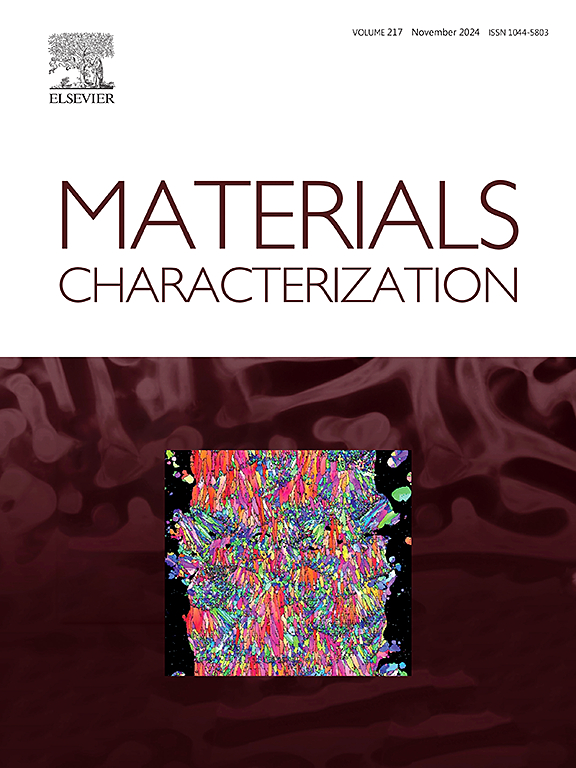Investigation on the microstructure and corrosion resistance of AlCoCrFeNi2Cu high-entropy alloy fabricated by laser cladding
IF 4.8
2区 材料科学
Q1 MATERIALS SCIENCE, CHARACTERIZATION & TESTING
引用次数: 0
Abstract
In this work, the AlCoCrFeNi2Cu high-entropy alloy (HEA) has been designed using the pseudo-binary design strategy, and the AlCoCrFeNi2Cu HEA cladding layer was prepared on the surface of 304 stainless steel by the laser cladding technique. The microstructure, microhardness, and electrochemical corrosion properties of the cladding layer were analyzed in detail. The optimal parameters of the laser power of 2200 W and the scanning sweep rate of 5 mm/s has been obtained. Under this laser cladding process parameters, the surface morphology of the cladding layer not only had slight defects and smooth edges but also had better metallurgical bonding. And the phase composition of the rapidly solidified HEA microstructures has been calculated by the Thermo-Calc software. The simulated results were in good agreement with the experimental results. The AlCoCrFeNi2Cu HEA cladding layer is composed of matrix phase (FCC (L12) phase) and intercrystalline phase (B2 phase), and a Cu-rich phase appears between the two phases. Meanwhile, the properties of the AlCoCrFeNi2Cu HEA cladding layer have been investigated. The microhardness of the AlCoCrFeNi2Cu HEA cladding layer is slightly higher than that of the substrate, with a maximum hardness value of 250 HV0.2. The potentiodynamic polarization curve and EIS test results show that the AlCoCrFeNi2Cu HEA cladding layer has higher self-corrosion potential, less self-corrosion current density, a larger capacitive reactance arc radius, and an impedance value higher than that of the 304 stainless steel. The corrosion resistance performance is slightly better than that of 304 stainless steel.
激光熔覆法制备AlCoCrFeNi2Cu高熵合金的显微组织及耐蚀性研究
本文采用伪二元设计策略设计了AlCoCrFeNi2Cu高熵合金(HEA),并采用激光熔覆技术在304不锈钢表面制备了AlCoCrFeNi2Cu高熵合金HEA熔覆层。详细分析了熔覆层的显微组织、显微硬度和电化学腐蚀性能。得到了激光功率为2200 W、扫描速率为5 mm/s的最佳参数。在该激光熔覆工艺参数下,熔覆层表面形貌缺陷小、边缘光滑,且具有较好的冶金结合性能。利用hot - calc软件计算了快速凝固HEA组织的相组成。模拟结果与实验结果吻合较好。AlCoCrFeNi2Cu HEA熔覆层由基体相(FCC (L12)相)和晶间相(B2相)组成,两相之间存在富cu相。同时,对AlCoCrFeNi2Cu HEA熔覆层的性能进行了研究。AlCoCrFeNi2Cu HEA熔覆层的显微硬度略高于衬底,硬度最大值为250 HV0.2。动电位极化曲线和EIS测试结果表明,与304不锈钢相比,AlCoCrFeNi2Cu HEA熔覆层具有更高的自腐蚀电位、更小的自腐蚀电流密度、更大的容抗弧半径和更高的阻抗值。耐腐蚀性能略优于304不锈钢。
本文章由计算机程序翻译,如有差异,请以英文原文为准。
求助全文
约1分钟内获得全文
求助全文
来源期刊

Materials Characterization
工程技术-材料科学:表征与测试
CiteScore
7.60
自引率
8.50%
发文量
746
审稿时长
36 days
期刊介绍:
Materials Characterization features original articles and state-of-the-art reviews on theoretical and practical aspects of the structure and behaviour of materials.
The Journal focuses on all characterization techniques, including all forms of microscopy (light, electron, acoustic, etc.,) and analysis (especially microanalysis and surface analytical techniques). Developments in both this wide range of techniques and their application to the quantification of the microstructure of materials are essential facets of the Journal.
The Journal provides the Materials Scientist/Engineer with up-to-date information on many types of materials with an underlying theme of explaining the behavior of materials using novel approaches. Materials covered by the journal include:
Metals & Alloys
Ceramics
Nanomaterials
Biomedical materials
Optical materials
Composites
Natural Materials.
 求助内容:
求助内容: 应助结果提醒方式:
应助结果提醒方式:


